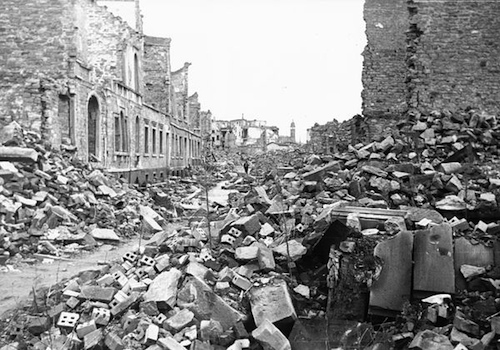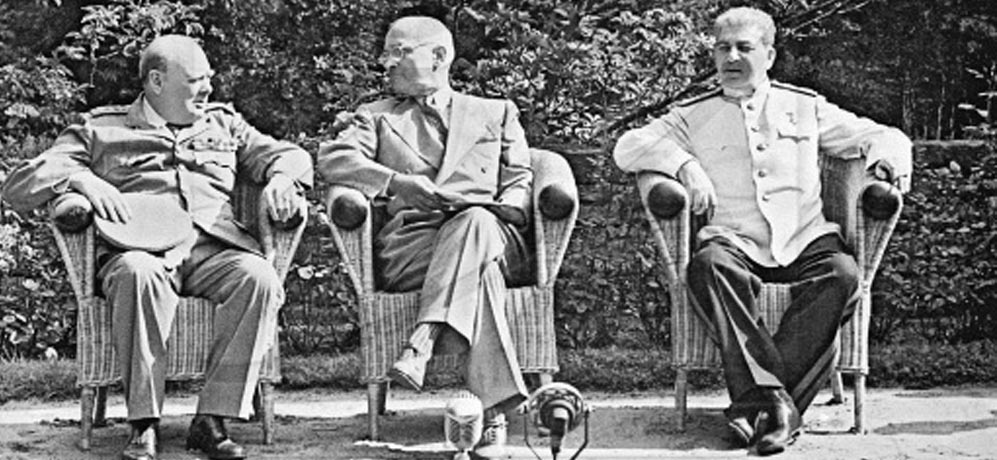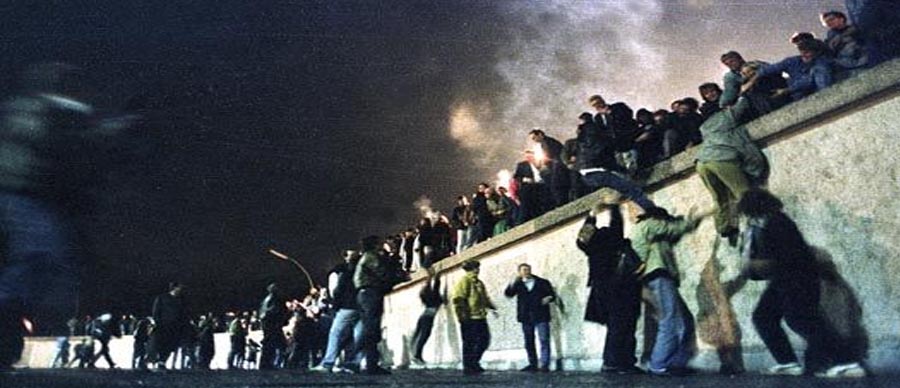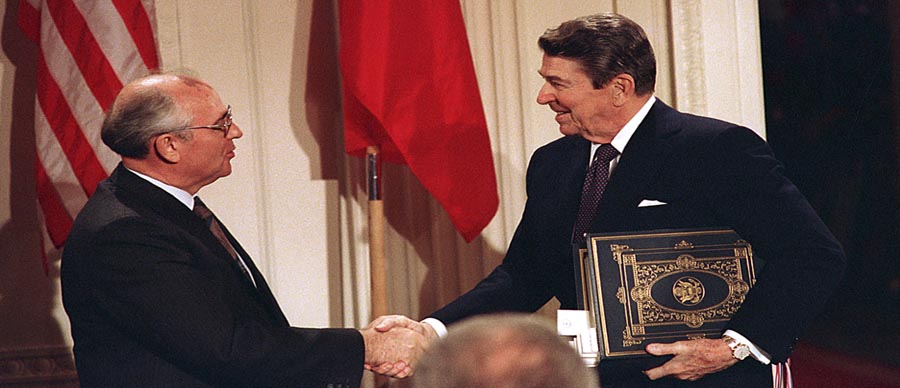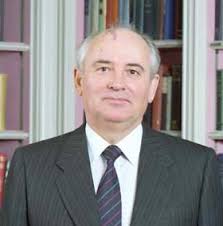
Mikhail Gorbachev was instrumental in the fall of the Berlin wall and the end of the cold war.
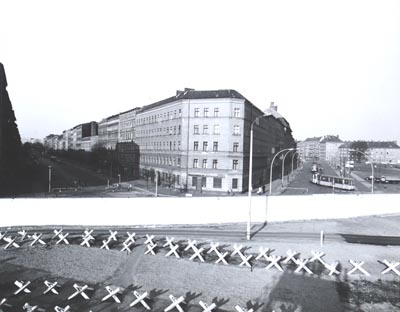
"The Anti Fascist Protection Barrier".
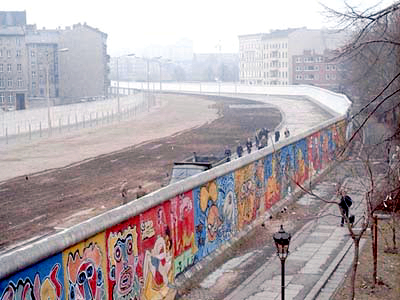
The Berlin wall was used as a canvas for many artists.
Germany After WW2
After Germany`s surrender after WW2, the Allies divided Germany into four occupation zones. A provisional administration was quickly set up, headed by the Allied Control Council. At the same time they supported the establishment of political groups in order to transfer the lands control in the long term to its own German government.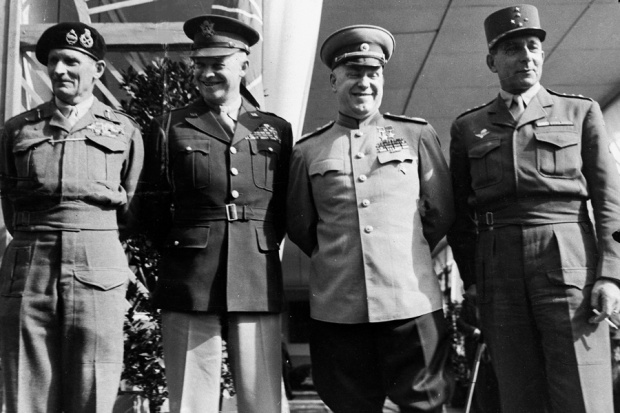 With the unconditional surrender of the Germans 7 / 8th May 1945 ended the Second World War. At the same time, the political existence of the German Reich was ended with Hitler's suicide. In the still employed by Hitler Government of the Grand Admiral Karl Doenitz, who until their arrest on 23 May 1945 led a shadowy existence in Flensburg could (its sole purpose was the capitulation). Germany was largely destroyed, conquered militarily and occupied by Allied troops. The defeat was complete. There was no German state authority. The great cities lay in ruins. Refugees and displaced people poured in from the eastern territories, in search of shelter and food, and a new home. Everyday life of the Germans was determined by hopelessness and exhaustion, apathy and concerns about missing relatives. The people of Germany were submissive and broken people who bent down on the streets picking up cigarette butts to smoke the tobacco residues in the end. Defeated, the feeling miserable, humiliated and victimized. The victorious Allies had enthusiastic Nazis expected and marveled that the Germans took just stunned as crimes of the Nazi was brought to the attention of the world. Of course they did not believe the people of Weimar, the horror that had been ordered and horrors at the liberated concentration camps, the world had little or no compassion for the defeated Germans.
With the unconditional surrender of the Germans 7 / 8th May 1945 ended the Second World War. At the same time, the political existence of the German Reich was ended with Hitler's suicide. In the still employed by Hitler Government of the Grand Admiral Karl Doenitz, who until their arrest on 23 May 1945 led a shadowy existence in Flensburg could (its sole purpose was the capitulation). Germany was largely destroyed, conquered militarily and occupied by Allied troops. The defeat was complete. There was no German state authority. The great cities lay in ruins. Refugees and displaced people poured in from the eastern territories, in search of shelter and food, and a new home. Everyday life of the Germans was determined by hopelessness and exhaustion, apathy and concerns about missing relatives. The people of Germany were submissive and broken people who bent down on the streets picking up cigarette butts to smoke the tobacco residues in the end. Defeated, the feeling miserable, humiliated and victimized. The victorious Allies had enthusiastic Nazis expected and marveled that the Germans took just stunned as crimes of the Nazi was brought to the attention of the world. Of course they did not believe the people of Weimar, the horror that had been ordered and horrors at the liberated concentration camps, the world had little or no compassion for the defeated Germans. The armies of the victors established themselves in the four occupation zones, Germany was divided for the purpose of administration and relief as agreed. To the extent necessary for military purposes, the destroyed infrastructure was poorly repaired: Sewer and temporary bridges and water and energy supply. For the military governments and occupying forces in the larger cities, counties, countries homes and offices were seized. The winners established themselves indefinitely. The occupation, that was for sure, would take a long time. On 5 June 1945, the winner made publicly known that the supreme authority in Germany was taken over by representatives of the four Allied powers and is exercised jointly by them. The "Declaration regarding the defeat of Germany" bore the signature of the four now in Germany's most powerful men, the Commander General Dwight D. Eisenhower (USA), Marshal Georgy Zhukov (USSR), Field Marshal Bernard Law Montgomery (United Kingdom) and General Jean de Lattre de Tassigny (France). They had met in Berlin in order in addition to some other documents to be signed on behalf of their governments this "Berlin Declaration", which was then published in English, Russian and French in the three future in and for Germany relevant languages. This June declaration reiterated the military terms of surrender and connected them with a notice of the measures that were before the Germans, including disarmament and demilitarization and arrest the Nazi leaders and war criminals. The key phrase was, would the governments in Washington, London, Moscow and Paris over the sovereignty over Germany ", including all the powers possessed by the German Government, the High Command of the Armed Forces and the governments, administrations and public authorities of the countries, cities and municipalities". The Four commander put their signatures to three other documents in force, in which the contours of the occupation regime over Germany were determined. It was "findings" about the control procedures, on the zones of occupation and to a third document in which the intention of the Governments of the four powers was expressed, "with the governments of other nations occasionally the exercise of power over Germany" to advise. All these papers were the result of inter-consultations since the beginning of 1944. The signing and promulgation in Berlin was mainly a demonstrative act which should indicate that Germany was now under occupation law. The meeting of the four supreme commander was basically already the first meeting of the Allied Control Council, which officially still during the Potsdam conference on July 30 in 1945 first appeared.
The Allied Control Council rapidly developed into an extensive bureaucracy. Twelve ministries with the tasks of ministries should pay under the name "directorates" the fate of Germany indefinitely. The directorates were occupied for reasons of parity each with four conductors. They formed committees and subcommittees, the proclamations, orders and regulations designed that - where the commander in chief among themselves could agree on - have been published in four languages Official Journal of the Control Council.
When setting up the zones of occupation, as they were finalized at Yalta in February 1945, there have been delays. In the southwest of the French refused to evacuate the cities of Stuttgart and Karlsruhe, who belonged to the US zone. They were like the French in April during the advance into the hands, and it took serious American threats to move the French to withdraw from Northern Wuerttemberg and North Baden. The Americans were themselves still in Thuringia, Saxony and Mecklenburg, in regions so that should be occupied by the Soviets. Unlike the French, the Americans had not intended to disregard the agreements with its allies. They handed in early July the Red Army these areas, much to the regret of the inhabitants who had rather stayed under American occupation. The Soviets had as pawns Berlin that - divided into four sectors - should be jointly managed by the Allies. Beginning in July 1945 American and British troops marched in Berlin, and took their sectors in to possession, in August followed by the French. The joint administration of Berlin took place in the "Command", which was directly under the Control Council. The presence of the three Western Allies in Berlin was basically more symbolic. The military governors resided for the Control Council officially in Berlin, but had their headquarters and task forces in their areas. In Baden-Baden General Pierre Koenig was established French military government. The Americans had set up their office in Frankfurt in the administration building of the IG Farben. The British had spread their headquarters in several places. The military high command was located in Bad Oeynhausen, the British military government was in Lübbecke, Herford and Minden. While the Western Allies had rods commute between Berlin and the zone headquarters ever, it had the Soviet military administration in Germany (SMAD) comfortable, they officiated in Berlin-Karlshorst. building up an institutional
The Potsdam Conference
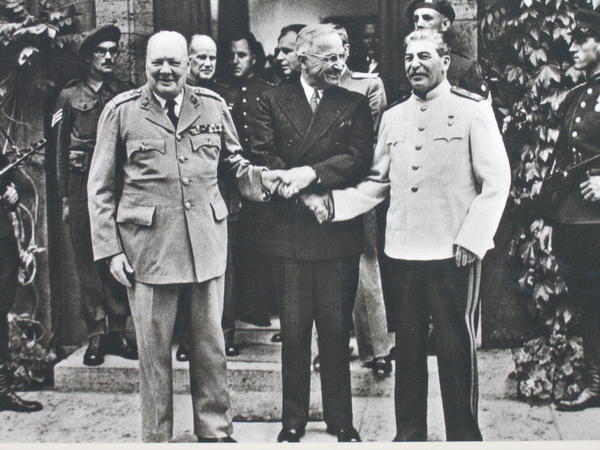 The Germans were of the complicated mechanism by which they were governed, with little. For them, the local military government was the supreme authority, which regulated their daily lives, giving orders, German agents and officials began again and replaced if they did not meet the expectations of the occupation regime. So it was the Lord Mayor of Cologne, Konrad Adenauer, the previously the Nazis in 1933 ousted. On the "White List" of the Americans he was the number 1, the beginning of May they put it back on as Mayor of Cologne. In early October put him the Englishman, in whose occupation zone Cologne now lay, for alleged "incompetence and lack of duty" again. The same thing happened the first Prime Minister of Bavaria and later Finance Minister, Fritz Schaffer, the American military government appointed in May 1945 and released again in September. Ererschien the occupying power too conservative. The recruitment unloaded German personnel was carried out in all four areas in a similar way to the "White List" containing the names of Hitler opponents and democratically minded politicians from the period before 1933. The lists were compiled long before the occupation of Germany. In the Soviet occupation zone, there were cadre staff, which consisted of communist emigrants who returned to Germany in the wake of the Red Army. Prepared in Moscow well on the task - - the Soviet military administration in setting up the administration in the Soviet occupation zone in Germany this the "Ulbricht Group" based on the Soviet airfield Calau (today KALAWA, Poland) ended on 30 April 1945 to part to help. The "Ulbricht Group" was destined for Berlin. Saxony and Mecklenburg were the areas of application of two other groups with Anton Ackermann (1905-1973, from 1946 Member of the Central Committee of the SED in 1954 excluded due to support from Rudolf Herrnstadt and Wilhelm Zaisser from the Central Committee) and Gustav Sobottka (1886-1953, 1947-48 President of the Central Administration for fuel industry, 1949-51 worked at the Ministry of Heavy Industry) at the top. Political life was first in all areas rather than at the lowest level; In denlokalen German administrations that were the occupying power responsible, parties played a minor role. Only the functioning of basic necessities was required at this level first.
The Germans were of the complicated mechanism by which they were governed, with little. For them, the local military government was the supreme authority, which regulated their daily lives, giving orders, German agents and officials began again and replaced if they did not meet the expectations of the occupation regime. So it was the Lord Mayor of Cologne, Konrad Adenauer, the previously the Nazis in 1933 ousted. On the "White List" of the Americans he was the number 1, the beginning of May they put it back on as Mayor of Cologne. In early October put him the Englishman, in whose occupation zone Cologne now lay, for alleged "incompetence and lack of duty" again. The same thing happened the first Prime Minister of Bavaria and later Finance Minister, Fritz Schaffer, the American military government appointed in May 1945 and released again in September. Ererschien the occupying power too conservative. The recruitment unloaded German personnel was carried out in all four areas in a similar way to the "White List" containing the names of Hitler opponents and democratically minded politicians from the period before 1933. The lists were compiled long before the occupation of Germany. In the Soviet occupation zone, there were cadre staff, which consisted of communist emigrants who returned to Germany in the wake of the Red Army. Prepared in Moscow well on the task - - the Soviet military administration in setting up the administration in the Soviet occupation zone in Germany this the "Ulbricht Group" based on the Soviet airfield Calau (today KALAWA, Poland) ended on 30 April 1945 to part to help. The "Ulbricht Group" was destined for Berlin. Saxony and Mecklenburg were the areas of application of two other groups with Anton Ackermann (1905-1973, from 1946 Member of the Central Committee of the SED in 1954 excluded due to support from Rudolf Herrnstadt and Wilhelm Zaisser from the Central Committee) and Gustav Sobottka (1886-1953, 1947-48 President of the Central Administration for fuel industry, 1949-51 worked at the Ministry of Heavy Industry) at the top. Political life was first in all areas rather than at the lowest level; In denlokalen German administrations that were the occupying power responsible, parties played a minor role. Only the functioning of basic necessities was required at this level first. Party foundation In parallel with the restoration of a German administration, which was acting on behalf of the occupying power, took place gradually the formation of political groupings. In the eastern zone of occupation of the Soviet Military Administration had by instruction no. 2 officially approved on 10 June 1945 the parties have been encouraging and the political activity. That was as it had been a coup the Soviet occupying power, which was staged before at the Potsdam Conference the three great victorious powers came together to discuss the principles of a common policy on Germany. On June 11, 1945 occurred in Berlin, the KPD with an initial appeal to the public in mid-June followed by the SPD, the CDU and the end of the month on July 5, was founded the Liberal Democratic Party (LDP). The effectiveness of these four parties stayed in Berlin and limited the Soviet Zone.
In the directive of the commander of the American occupation forces in Germany, which was immediately after the war, it was said in general that there is no political activity to privileged treatment without permission of the military governor. Speech, press and religious freedom should be granted to the Germans, provided that such non-military interests would be adversely affected. The distribution of the Nazi, militaristic and nationalistic doctrines is also to prohibit such "marches military, political, civilian or sporting nature". The rules Manual of the US Army, which informed the officers of the American military government over the occupation policy stipulations contained, under the heading "Political Activities" four theses that should serve as a guideline:
All democratic parties should be encouraged, if possible in the whole of Germany;
Support political office should have to face regularly the public discussion of their program and elections;
Elections were conducted under the same conditions for all, and with at least two competing parties;
Political parties should be democratic, developed and separated by the institutions of governance through voluntary integration.
Those were fundamental considerations, as they were seen as a matter of course in the US. In Germany, these principles had to be learned and practiced but only again, initially in the towns and smaller towns. CDU, CSU and SPD At this level, the activities of German parties were in the US zone from August 1945 approved. Requirement was, as well as in the British and French zones, the acquisition of a license. This required an application to the competent military government made, which in addition to the party program, the statutes, a financing plan and answering many questions had to be attached (for example, about intention to party propaganda) the signatures of supporting. The applications were when everything was put in order, approved at the county level. The parties' activities were monitored by the military government. The parties in 1933 prohibited labor movement, KPD and SPD, which could revive her old organizational structures and their potential membership again, appeared from the summer of 1945 in many places as the first on the political stage, followed by the new grouping of the Christian Democratic Union (CDU) and Bavarian Christian Social Union (CSU). This new grouping spoke as a bourgeois coalition movement to the potential voters of Catholic center (or the Bavarian People's Party) as well as Protestant political layers. The novelty was the confessional pluralism this on Christian principles socially engaged CDU and CSU parties, which were about the same rate as the SPD in the three Western zones. The merger in regional associations were allowed later, only in the British and Soviet occupation zone, the Party organization at the zone level was possible. By returning from years of incarceration Kurt Schumacher, the SPD rebuilt from the spring of 1945, this party was but one in all zones unified name a charismatic leader figure that by the allied specifications the SPD as überzonale unified party understood undeterred. However, the western SPD bordered against the leadership of the East German SPD under Otto Grotewohl from as well as to all offers to cooperate with Communists. unification of the working parties , the KPD enjoyed the preferred funding by the Soviet military administration. They propagated the required also by members of the SPD merger of the two workers' parties. That should, in the understanding of the Social Democrats, as a lesson from history, can oppose the consequence of the suffered powerlessness against Hitler, the divided and warring labor movement despite their numerical strength had no effective resistance. Given the experience of the Soviet rule, the euphoria, however, was long since given a deep skepticism. Many Social Democrats were convinced that the German Communist Party, supported by the Soviet military government, the SPD would use in a merger only for their intentions. The propaganda for the creation of a single Workers' Party (the KPD them operating under the influence of the poor performance of the Communist parties in the House in Austria and Hungary elections) therefore found little resonance in the SPD in the Western zones. In the eastern zone of significant Soviet pressure was necessary to enable took the founding congress of the Socialist Unity Party (SED) in East Berlin's Admiralspalast on 21 and 22 April 1946. Otto Grotewohl (SPD) and Wilhelm Pieck (KPD) were unanimously elected to equal chairmen of the SED. In the Western Zones and the Western sectors of Berlin, the Social Democrats rejected by a large majority the union from. The SPD, for the merger in the East Zone to the trauma was, headed in the years that followed under Kurt Schumacher a strictly anti-communist course. About Regional unions for the Christian Democratic parties that had organized in December 1945 in Bad Godesberg a "Reich meeting" Konrad Adenauer was gradually leading to the figure. He was elected the end of February 1946 Chairman of the CDU in the British zone and used this position to ward off the claim to leadership of the CDU the Soviet occupation zone. The party was both programmatically as well as organizationally heterogeneous. The spectrum ranged from the world of ideas of the Christian socialism (in the AhlenerProgramm February 1947, expressed) to more conservative views and decided federalism the Bavarian CSU. Besides the common name CDU and CSU (decided in Godesberg in December 1945) formed the Christian Democrats until the first national convention in October 1950, only a consortium of independent parties. Still greater diversity among liberals that in the East Zone in July 1945, the Liberal -Demokratische Party (LDP) founded and in the western zones under names such as People's Democratic Party itself (Württemberg) or Free Democratic Party (FDP) had come together in North Rhine-Westphalia. Other political parties were established on a regional basis and licensed by the Allies, namely new associations such as the Bayern party or the Lower Saxony State Party (later German Party) and old parties of the Weimar Republic as the Catholic Centre Party, which revived. Also dazzling formations such as the Economic Construction Association (WAV) in Bavaria arose. All of them were chosen and were transient important. However, two types of parties had no chance to get a license from the occupying powers, namely right-wing extremist groups and those parties who wanted to act as advocacy of expellees and refugees. The former were incompatible with the democratization bid (hence the license application a Bavarian royal party was rejected) and refugees parties were not allowed, because the Allies pushed for fastest possible full integration of all new citizens in their zones of occupation.

